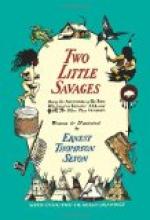“Le’s see, you want twice twenty-four—that’s forty-eight feathers.”
“No,” said Yan, “that’s a poor feathering, two on each. We want three on each arrow—seventy-two strips in all, and mind you, we want all three that are on one arrow from the same side of the bird.”
“I know. I’ll bet it’s bad luck to mix sides; arrows doesn’t know which way to turn.”
At this moment Si Lee came in. “How are ye gettin’ on with the bows?”
“Waitin’ for arrows now.”
“How do ye put on the feathers?”
DESCRIPTION OF SIX SAMPLE ARROWS SHOWING DIFFERENT FEATHERS
A is a far-flying steel-pointed bobtail, very good in wind. B is another very good arrow, with a horn point. This went even better than A if there were no wind. C is an Omaha war and deer arrow. Both heads and feathers are lashed on with sinew. The long tufts of down left on the feathers are to help in finding it again, as they are snow-white and wave in the breeze. The grooves on the shaft are to make the victim bleed more freely and be more easily tracked. D is another Omaha arrow with a peculiar owner’s mark of lines carved in the middle, E is a bone-headed bird shaft made by the Indians of the Mackenzie River. F is a war arrow made by Geronimo, the famous Apache chief. Its shaft is three joints of a straight cane. The tip is of hard wood, and on that is a fine quartz point; all being lashed together with sinew.
“White-men glue them on, and Injuns lash them on,” replied Yan, quoting from memory from “that book.”
“Which is best?”
“Glued on flies better, but lashed on stands the weather better.”
“Why not both?”
“Have no sinew.”
“Let me show ye a trick. Where’s yer glue an’ linen thread?”
These were brought, whereupon Si added: “’Pears to me ye oughter put the feathers on last. Better cut the notch first.”
“That’s so; we nearly forgot.”
“You nearly forgot, you mean. Don’t drag me in the mud,” said Sam, with owlish dignity. A small saw cut, cleaned up and widened with a penknife, proved the best; a notch one-fourth inch deep was quickly made in each arrow, and Si set about both glueing and lashing on the feathers, but using wax-end instead of sinew.
Yan had marked the place for each feather so that none would strike the bow in passing (see Cut page 183). He first glued them on, then made a lashing for half an inch on the projecting ends of the feather-rib, and another behind, carrying this second lashing back to the beginning of the notch to guard against the wood splitting. When he had trimmed all loose ends and rolled the waxed thread well on the bench with a flat stick, the threads seemed to disappear and leave simply a smooth black ring.
THE ARCHERY OUTFIT (Not all on scale)
I. The five-foot bow as finished, with sections at the points shown.




